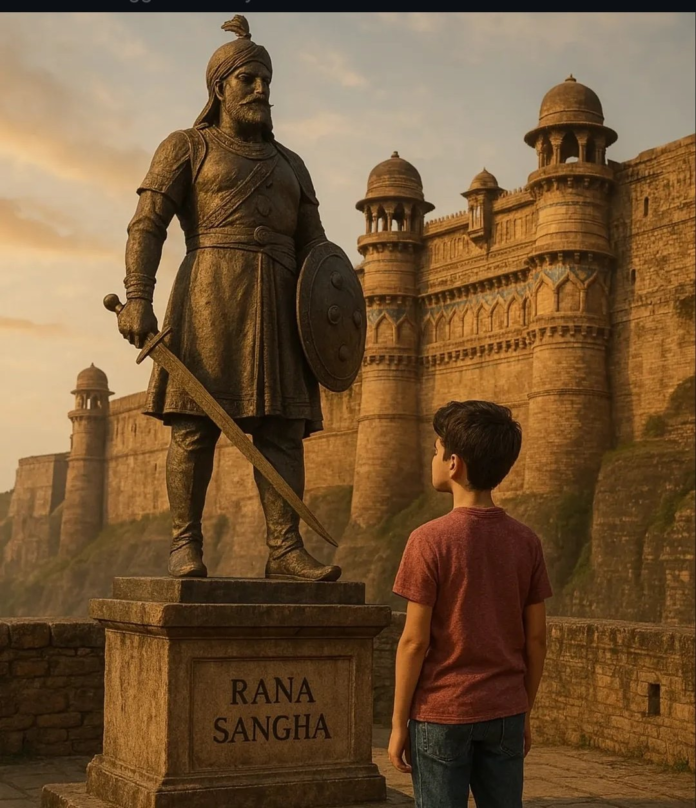
By Anjali Solanki
“In the heart of Mewar, where courage was forged in the fires of adversity, a warrior king rose to etch his name in the annals of history Maharana Sangram Singh, the indomitable Rana Sanga.”
As we commemorate Maharana Sanga Jayanti, we honor a towering figure whose life was a testament to valor, unity, and unrelenting defiance against overwhelming odds. Born on April 12 in 1482 in Chittorgarh, Rana Sanga, the ruler of Mewar from 1508 to 1528, was not just a king but a symbol of resistance and resilience. His historical contributions reshaped the landscape of northern India in the 16th century, and his legacy continues to inspire generations to stand firm in the face of challenges. This article explores who Maharana Sanga was, his monumental contributions, and how today’s youth can draw inspiration from his extraordinary life.
Who Was Maharana Sanga?
Maharana Sangram Singh, popularly known as Rana Sanga, was a scion of the Sisodia dynasty, one of the most revered Rajput clans of Rajasthan. Ascending the throne of Mewar after a fierce struggle with his brothers, Sanga inherited a kingdom surrounded by powerful sultanates. Despite losing an eye, an arm, and bearing over 80 wounds from countless battles, he transformed Mewar into a formidable power, uniting Rajput clans and challenging the might of Delhi, Malwa, and Gujarat. His capital at Chittorgarh stood as a beacon of Hindu sovereignty in a time of relentless invasions.
Historical Contributions of Maharana Sanga
- Unification of Rajput Clans
In an era when Rajputana was fragmented by internal rivalries, Rana Sanga achieved the near-impossible uniting warring Rajput clans through diplomacy and marital alliances. By forging a confederacy of Rajput states, he created a unified front against external threats, laying the groundwork for collective resistance. This unity was a precursor to later Rajput defiance, notably under his grandson, Maharana Pratap.
Sanga’s military campaigns were legendary. He expanded Mewar’s boundaries across present-day Rajasthan, Gujarat, Madhya Pradesh, Haryana, and parts of Uttar Pradesh.
His victories in battles like Khatoli (1517), Dholpur (1518), and Gagron (1519) against the Lodi dynasty and Malwa Sultanate showcased his tactical genius. At its zenith in 1521, his empire stretched from Malwa in the south to the borders of Agra, earning him the allegiance of nearly all Rajput chiefs.
Sanga’s most defining contribution was his resistance against Babur, the founder of the Mughal Empire. In 1527, he led a Rajput coalition against Babur at the Battle of Khanwa. Though defeated due to Babur’s innovative use of gunpowder, Sanga’s initial successes at Bayana and his fearless stand inspired future generations to resist foreign domination. He is regarded as one of the last independent Hindu rulers of northern India to control vast territories.
Beyond the battlefield, Sanga was a patron of the arts and a defender of religious tolerance. He supported poets like Malik Muhammad Jayasi, author of Padmavat, and ensured that people of all faiths could practice freely in Mewar. His reign saw Mewar flourish as a cultural hub, preserving Rajput traditions amid turbulent times.
Sanga’s body bore the scars of his commitment 80 wounds, a lost eye, a severed arm, and a crippled leg. Yet, he never wavered. His death in 1528, possibly due to poisoning by his own nobles after refusing to submit to Babur, marked the end of an era. However, his spirit of defiance lived on, inspiring his successors, particularly Maharana Pratap, to continue the fight for independence.
Lessons for Today’s Generation
Maharana Sanga’s life offers profound lessons for the youth of today, navigating a world of rapid change and challenges. Here’s how his legacy can inspire Despite physical injuries and constant threats, Sanga never backed down. His resilience teaches us to face personal and professional setbacks with determination. Whether it’s overcoming academic struggles, workplace challenges, or personal loss, Sanga’s life reminds us that true strength lies in perseverance.

